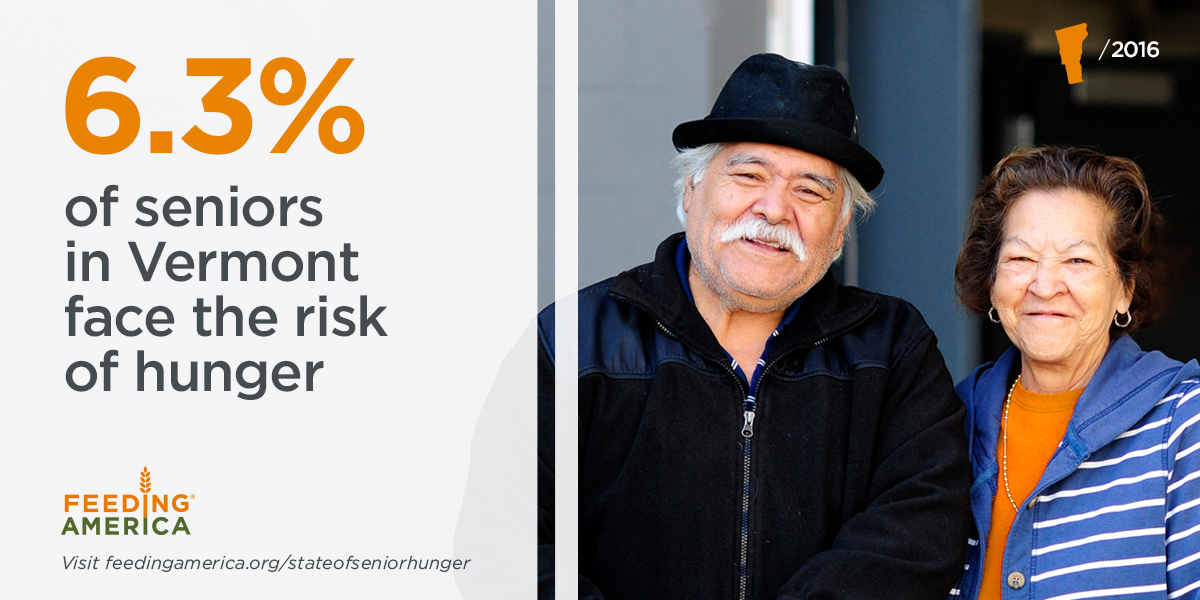Older adults face hunger at a higher rate today than before the great recession despite economic improvements
Two-thirds of Food-Insecure Seniors Have Incomes Above Poverty Line 
BARRE – May 24, 2018 – The Vermont Foodbank announced today the release of The State of Senior Hunger in America in 2016, a study about food insecurity among older Americans published by Feeding America® and The National Foundation to End Senior Hunger (NFESH). The report shows that 4.9 million people age 60 or older (7.7 percent) were food insecure in 2016 across the U.S. In Vermont, the food insecurity rate for seniors is 6.3 percent.
Nationally, seniors with the lowest incomes are most at risk of being food insecure, yet about two-thirds of food-insecure seniors have income above the federal poverty line. As a result, many seniors likely do not qualify for federal nutrition programs like the Supplemental Nutrition Assistance Program (SNAP) or the Commodity Supplemental Food Program (CSFP).
“Here in Vermont, the Vermont Foodbank is committed to ensuring that all of our older neighbors have access to the food they need to live fulfilling, healthy lives,” says John Sayles, CEO at the Vermont Foodbank, a member of Feeding America. “In partnership with SASH senior housing sites, we share healthy fresh food and pantry staples with residents at their homes. Through the Commodity Supplemental Food Program (CSFP), we provide nearly 2,400 eligible Vermonters over the age of 60 with boxes of nutritious staple foods delivered to their communities. Our SNAP outreach team also works to help older Vermonters navigate the process of signing up for SNAP benefits. These are just a few of the ways that we work every day to make sure the Vermont Foodbank is there for our older neighbors when and where they need it.”
The issue of food insecurity among the elderly is larger than the lack of access to nutritious food alone. Research also demonstrates that food insecure seniors are at much greater risk of being diabetic, suffering from depression, having congestive heart failure, experiencing a heart attack or having asthma than food-secure elders.
“Many Older Americans encounter a myriad of issues the general population does not face, including health conditions, transportation challenges, and physical limitations,” said Feeding America President Matt Knott. “At Feeding America, we are looking at ways address food-insecure seniors’ unique needs, so that they can live fuller, more food-secure lives, with as much dignity and independence as possible.”
This latest report documents the characteristics of seniors who struggle to meet their nutritional needs. Specifically, in 2016, researchers found:
- Seniors who are racial or ethnic minorities, low-income or younger vs. older (age 60-69 vs. age 80+) were most likely to be affected by some level of food insecurity.
- Seniors who reported a disability were disproportionately affected, with 24 percent reporting food insecurity.
- Senior food insecurity rates vary by state, ranging from 3.4% in North Dakota to 14.1% in Louisiana. Vermont, with 6.3% of seniors food insecure, falls in the low end of that range.
- Seniors living in the South are more likely to experience food insecurity than seniors living in other parts of the country.
The State of Senior Hunger in America in 2016 was produced by Feeding America in partnership with NFESH. The study was conducted by researchers Dr. James Ziliak and Dr. Craig Gundersen and is the source for national- and state-level information about food insecurity among seniors age 60 and older. The full report can be found here.
